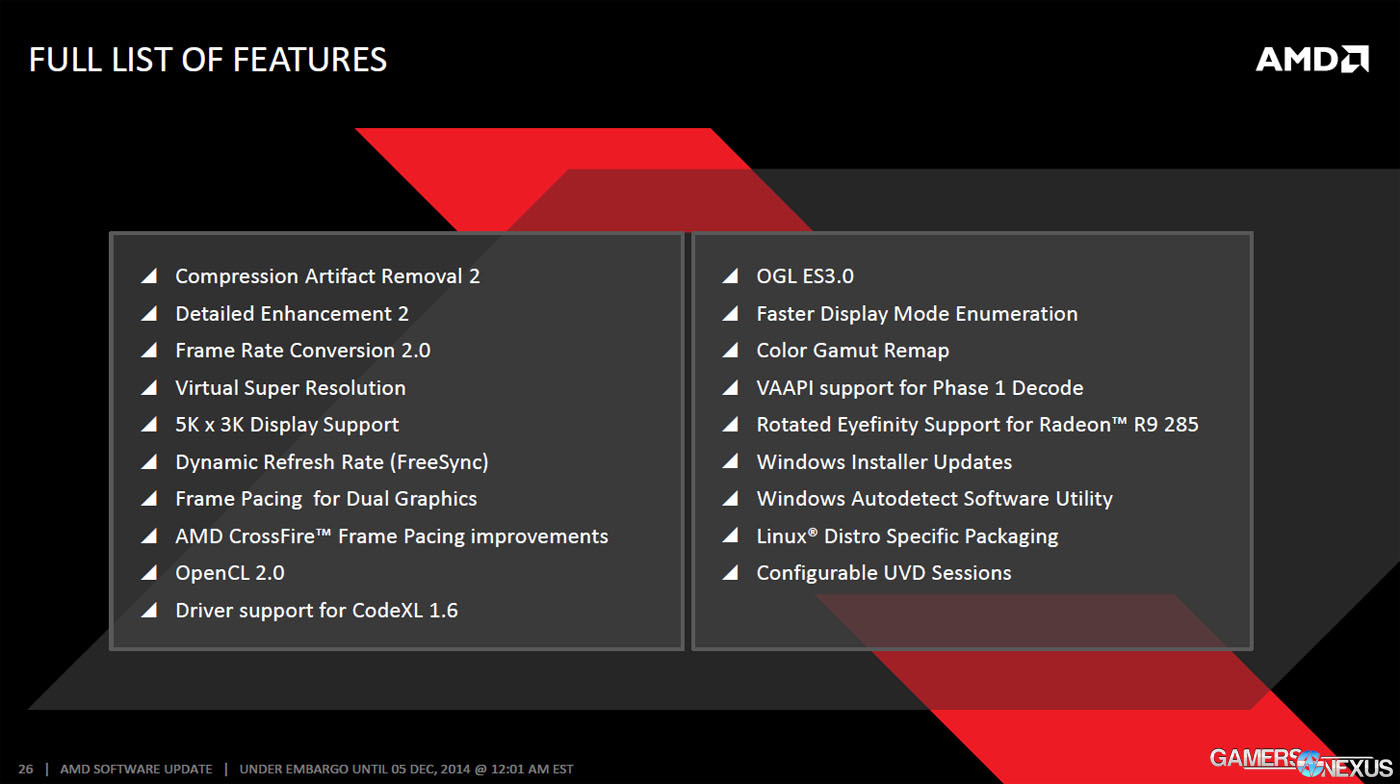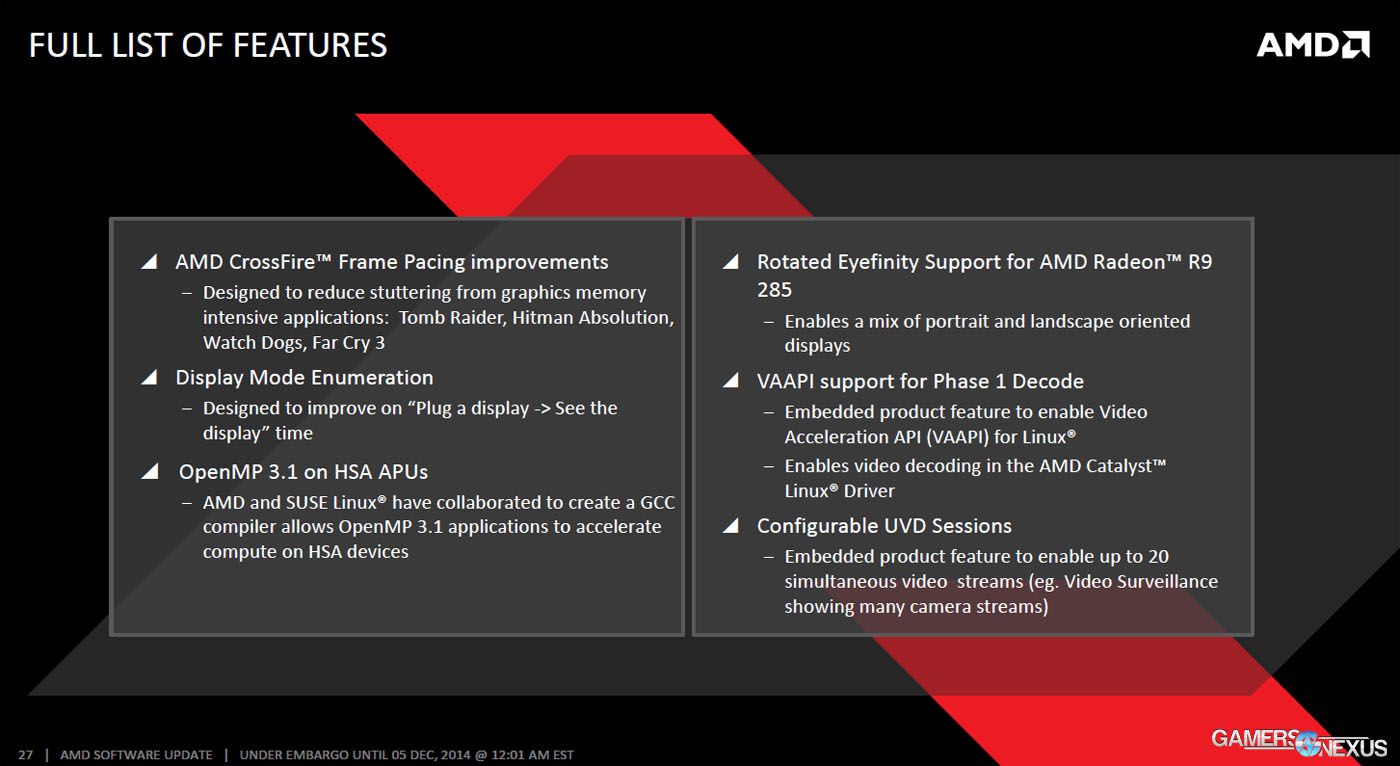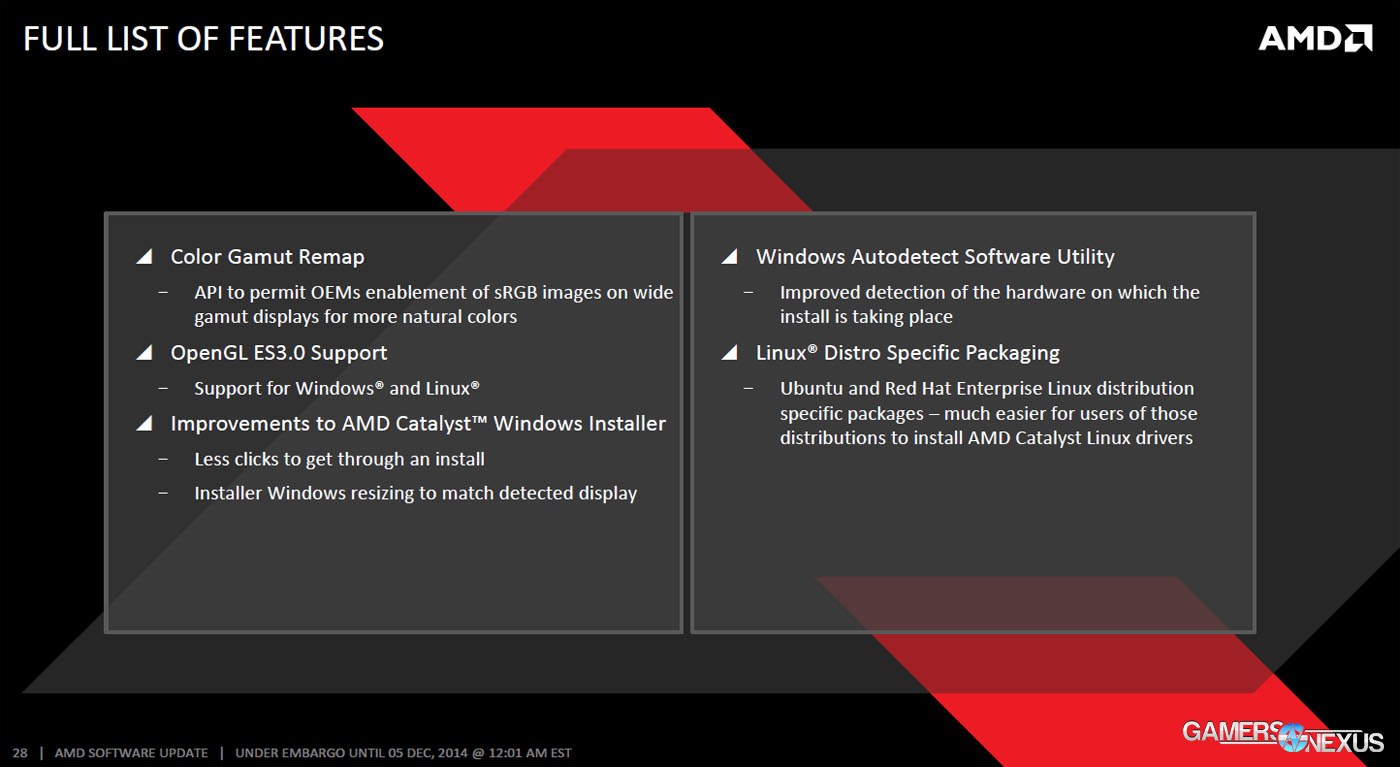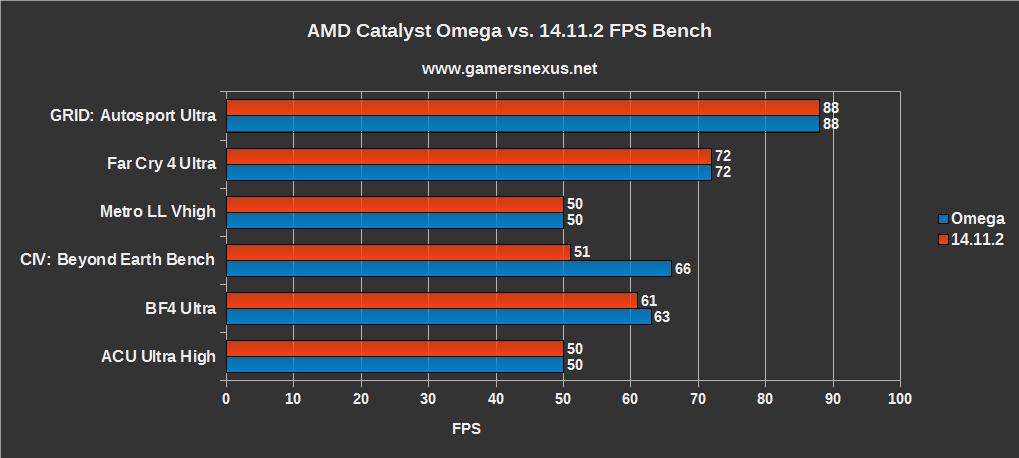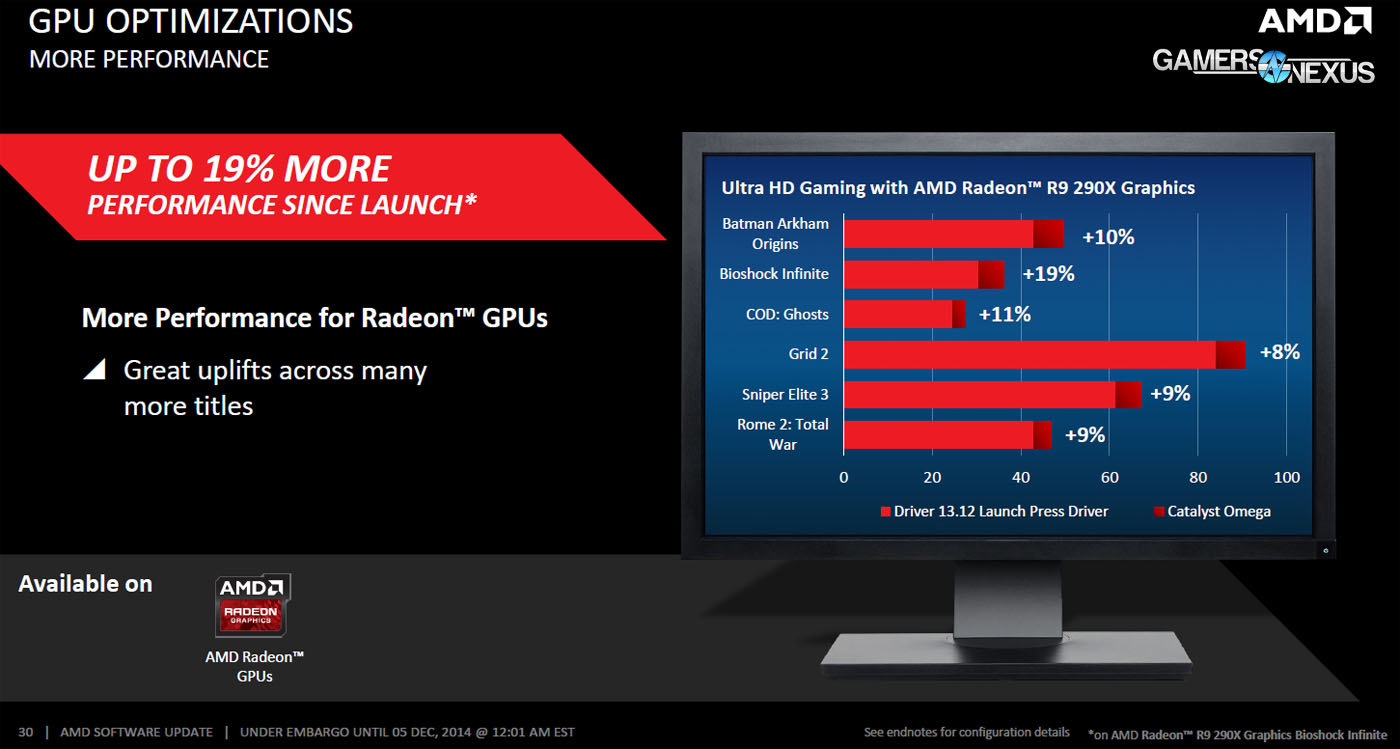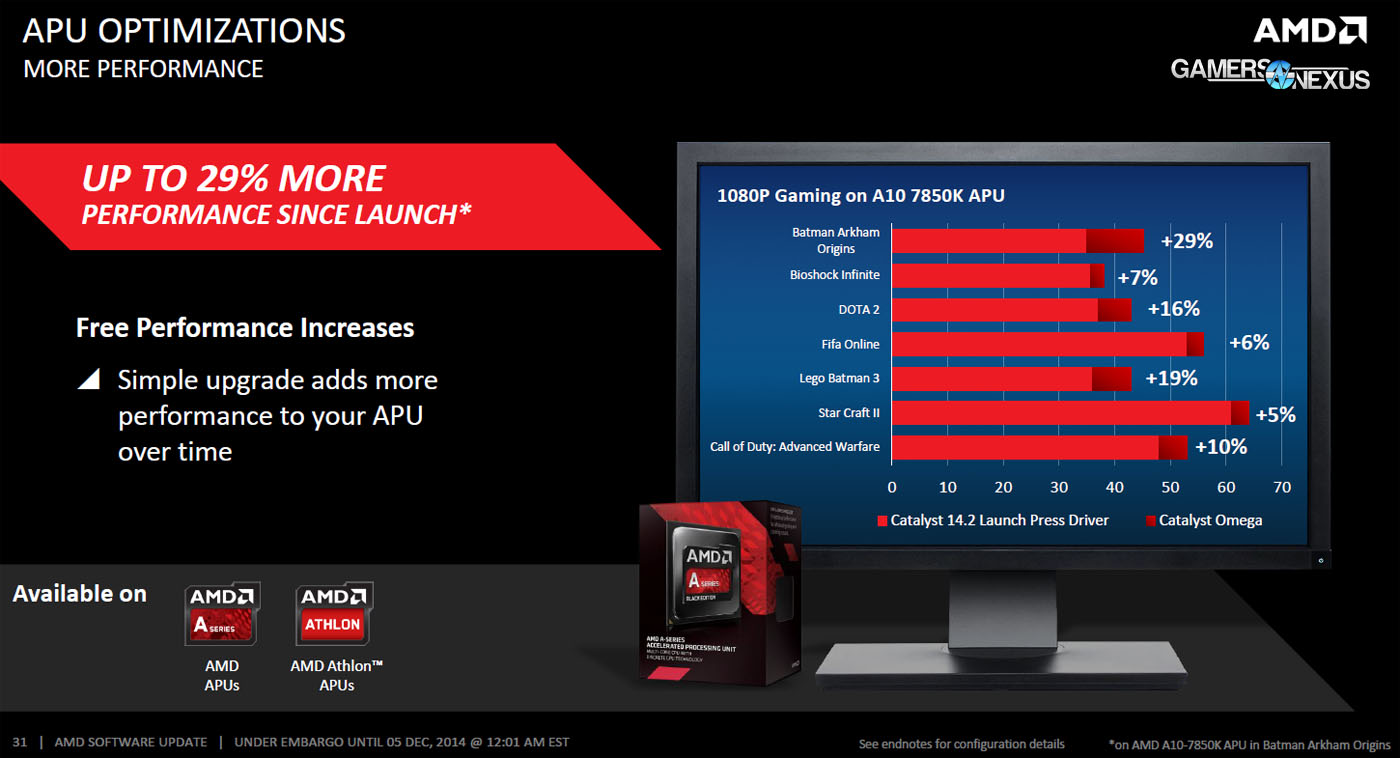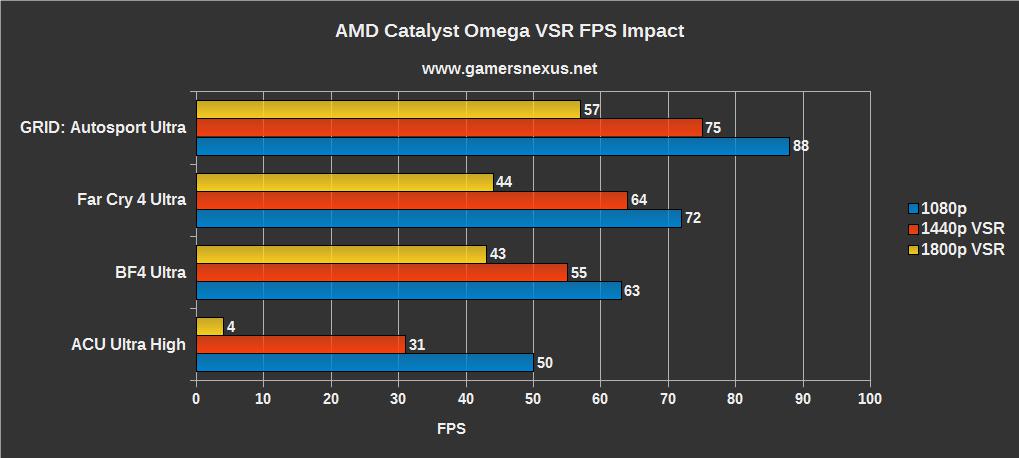In a bid to garner attention in the graphics market, AMD's Radeon graphics division has branded its newest Catalyst driver update simply as “Omega.” Unlike previous iterations, the new driver attaches a codename to symbolize the dramatic changes made to the underlying software. Catalyst Omega introduces direct competitors to NVIDIA technology (like DSR, seen here), offers greater Linux support, and hosts a suite of media playback smoothing options. We'll look into all of those here, along with some driver benchmarks.
Here's a quick overview, as provided by AMD (note that AMD's numbers differ from our benchmark numbers, shown and explained further below):
The major new features for Catalyst Omega include:
Gaming Updates
- VSR (Virtual Super Resolution, thought of as an alternative to nVidia's Dynamic Super Resolution – DSR).
- Frame Pacing & Frame Time improvements. Several games see frame time improvements over previous driver iterations. This means frames are delivered more consistently with even spacing between each frame. Frame pacing has been improved slowly since 14.9, so users of 14.11.2 will see very little difference. Games affected include Batman, Metro, Tomb Raider, & Sniper Elite 3.
- Presumably some game performance enhancements, though we saw these in limited extent when compared to the recent 14.11.2.
FreeSync
- AMD's FreeSync driver support now exists in Omega. At this point, we're just waiting for monitors that also support the tech. Samsung and other major brands have already announced FreeSync inclusion, with numerous models being unveiled at CES and shipping in 2015.
Video Playback Updates
- Fluid Motion Video, which interpolates frames to improve video playback fluidity. This is done with a temporal (time-based) filter, tasked with analyzing the previous frame and next frame, then “filling in the gaps” with an interpolated frame. An example would be a car chase scene that jitters as a result of the high speed. This applies strictly to CyberDVD and similar multimedia viewers; Fluid Motion Video does not apply to games. This tech relies upon GPU compute to process.
- Contour Removal. As above, this only applies to multimedia playback. Contour removal decreases the count of compression artifacts by using a new algorithm for interpreting compressed videos.
- Detail Enhancement on APUs & GPUs. Detail enhancement assists lower-resolution displays – like those found on laptops – by providing the detail of 1080p video on lower resolution outputs. This can be thought of as similar in top-level concept to VSR, in that the output frame appears higher in detail and depth.
- Adaptive Upscaling. Takes 1080 content and upscales it in a fashion that theoretically provides a comparable appearance to true 4K output. This is used on 4K displays that do not have matching 4K content.
- FRC. Framerate Conversion adapts slower FPS movies to higher framerates. The Hobbit was shot at 48FPS, but most media is still 24-30p. FRC ups the FPS to match the display refresh rate.
Linux Updates
- Linux support. AMD will upstream all code that affects features, performance, and stability into open source community Radeon drivers. D3D and OpenGL remain proprietary, but everything else goes into open source respositories.
- OpenCL 2.0 support gives access to a new range of general purpose computing, making things easier to work with. OpenCL 2.0 smooths the edges of OpenCL 1.2/1.3 with HSA now being OpenCL compliant, meaning that HSA-related programming will now run OpenCL 2.0 code as well.
- CodeXL support allows OpenCL applications to analyze software power consumption in Watts.
AMD's Promises
AMD has made a lot of promises in its time. This release, they've stuck to at least a few of them. More than 400 major driver bugs have been resolved, including several directly related to instability and driver crashes (and CrossFire / Quad CrossFire stability improvements). That said, AMD has also made new promises: With the restructuring of the organization, the company notes that day-1 game release drivers will be readily available alongside “big features” released yearly. Stability is a major focus for Catalyst going forward.
Catalyst Omega Benchmark
Sadly, the performance jump from 14.11.2 to Omega is pretty dull and uninteresting, likely because much of the code that went into Omega stemmed from the 14.11.2 beta. We did test VSR vs. DSR for the delta FPS degradation, though, which produced some surprising numbers.
Here's the FPS bench:
This chart shows the 1920x1080 performance difference between 14.11.2 and Catalyst Omega on the 4GB 290X ($370). We saw improvements in Civilization: Beyond Earth, but no noteworthy games in other applications. AMD's internal reporting shows major performance jumps with Omega, but reading the fine print reveals that these tests were conducted on much older driver versions – like 14.9 and even 13.x releases of Catalyst. In the event you're on drivers from several months ago, you'll see much larger performance gains than we've reported above.
This chart shows AMD's internal metrics against older versions of Catalyst, for comparison purposes.
AMD VSR vs. NVIDIA DSR
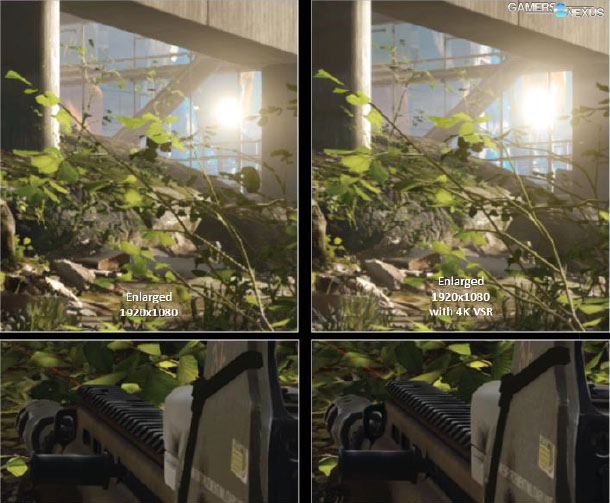 Pay close attention to the foliage jaggies.
Pay close attention to the foliage jaggies.
Virtual Super Resolution – like Dynamic Super Resolution – renders games at a higher resolution and then filters them down to the display's native resolution. The result is smoother edges on some textures and overall greater detail, at the cost of a performance hit. Note that the game is still being rendered at a higher resolution, so playing at 4K via VSR / DSR will minimally tax the hardware in the fashion a true 4K display would do.
VSR is only compatible with the 295X2, 290X, 290, and 285. The R7 family might get support in 2015. The scaler in the 290 family limits resolution upscaling to 3200x1800, whereas the R9 285 (and similar family cards) will allow 4K VSR.
The raw performance hit looks like this:
As for how VSR and DSR differ, it appears that VSR has a more immediate performance advantage when strictly looking at deltas (the % FPS difference between 1080p and the virtual resolution render, i.e. the FPS drop from 1080 to 1440 or 3200x1800). We only tested two titles for now, so this is by no means definitive.
| NVIDIA FPS Hit | AMD FPS Hit | ||
| Far Cry 4 Ultra | 1080p | 0 | 0 |
| 1440p | -26% | -11.77% | |
| 1800p | -62.4% | -48.3% | |
| GRID: Autosport Ultra | 1080p | 0 | 0 |
| 1440p | -18% | -15.96% | |
| 1800p | -49.10% | -42.76% |
We require further testing to determine whether VSR and DSR achieve the same quality output – it may be the case that DSR is performing additional processing, but we'll be researching this shortly.
The above shows AMD's VSR in Battlefield 4 (Top - 1080; Bottom - 1440). Focus on the trees and grass to see the difference.
AMD's moving in the right direction, but there's no doubt that they've still got ground to make up in all of their markets. Let us know what your experience has been with Omega thus far. The driver should be available today: http://community.amd.com/community/amd-blogs/amd-gaming/blog/2014/12/08/a-very-special-edition-driver-amd-catalyst-omega
- Steve "Lelldorianx" Burke.
